
On this cold, clear blue day, the ground beneath my feet is damp, muddy, covered with bruised leaves and discarded cores, and I have to concentrate on each step to make sure my shoes don’t slip.
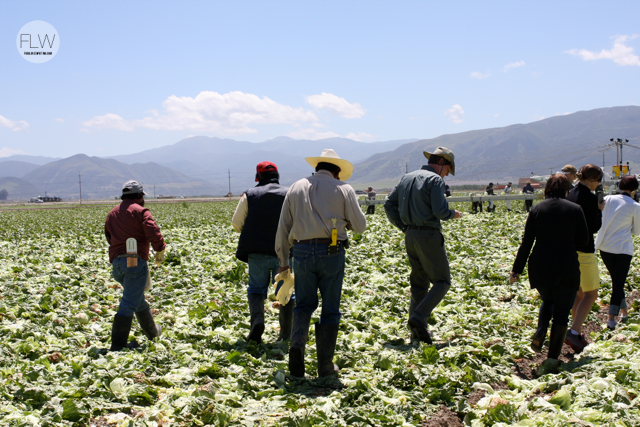
It’s morning, the time of day when this work is usually done, although it typically begins hours before the sun comes up, and Tim is just ahead of me, moving towards the low rumble of a wide, slowly rolling machine where workers are pulling green globes from the ground by hand, cutting out each individual core with a single swift stab, scraps falling to the field as fertilizer behind them, then washing the lettuce and placing it on a conveyor belt that takes them to boxes bound for processing.
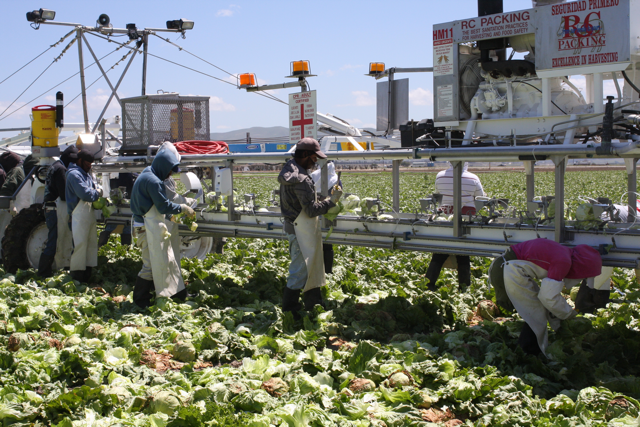
We’re in California, about an hour outside Monterey, standing, along with a dozen or so other bloggers, in the middle of one of Dole’s iceberg lettuce fields.
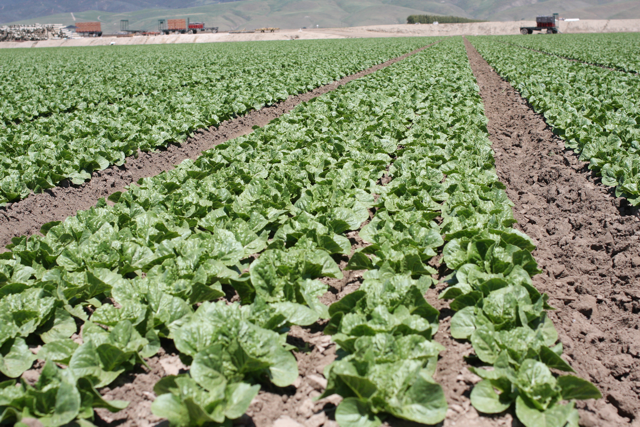
A tall man in blue jeans, Mark Pisoni, tells us he’s a third-generation farmer providing produce for Dole. Another man, also from Dole, demonstrates with a corer in hand how lettuce harvesting is done, pulling one head after another into his arms.
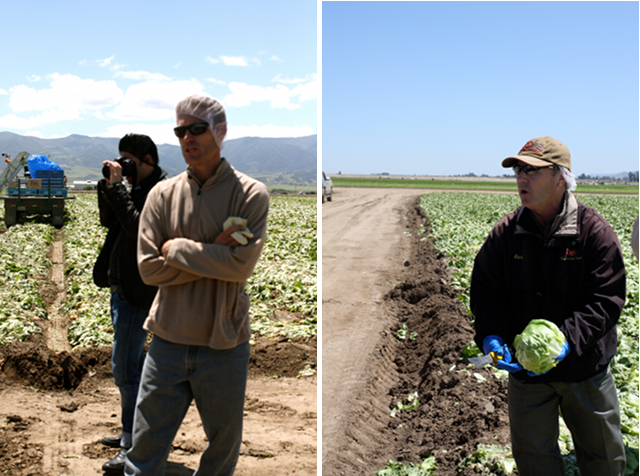
Dole’s already told us at their Monterey headquarters that they work with over 9,000 small growers, many of whom they’ve had decades-long relationships with, and now they’re showing us. Pisoni’s family farms 500 acres of iceberg lettuce, romaine, celery, broccoli, and cauliflower in the Salinas Valley, working on land that’s been in his family for close to 100 years.
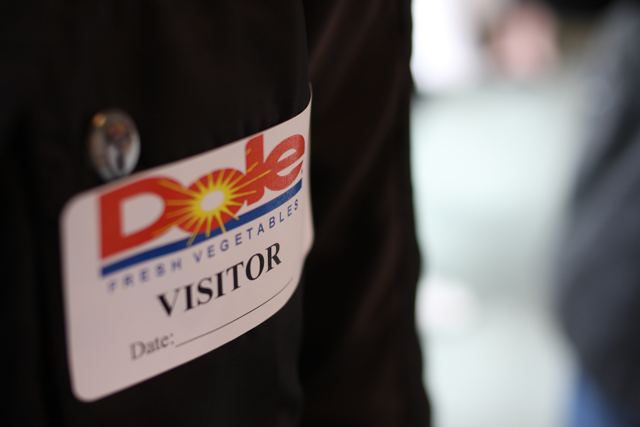
They take us to a Dole processing plant, where we see the same kinds of lettuce that was just harvested get washed, chopped and packaged.
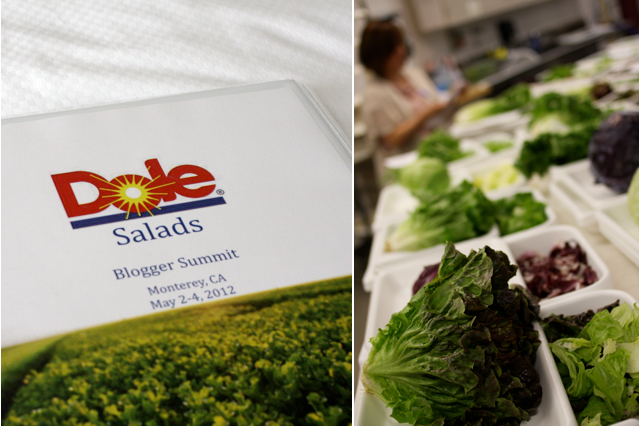
We brush up on our salad knowledge through a “name that lettuce” quiz I was sure Tim was going to win (who knows the difference between red tango lettuce and Salanova? Turns out my husband does!). We are briefed on Dole’s Salad’tude campaign—a new marketing approach that centers on finding your own personal salad style, and we’re asked for our thoughts on salad/vegetable trends and what we see happening in the industry.
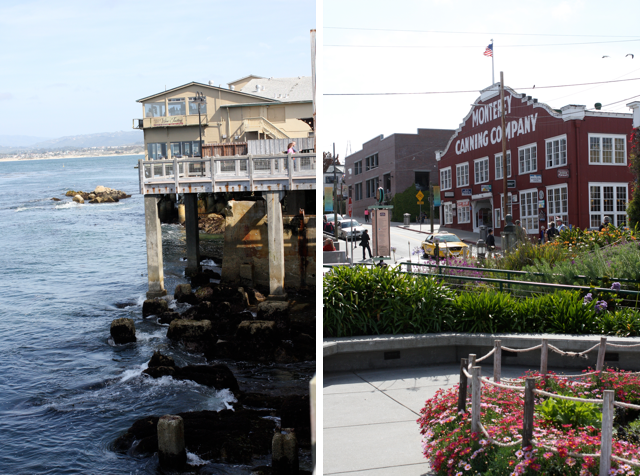
All of this happens in and around Monterey, California, a beautiful oceanside city with the feel of a rich, temperate beach town. And now that I’m seeing all the natural beauty (and bounty!) northern California offers, I’m totally understanding why everyone wants to live here.

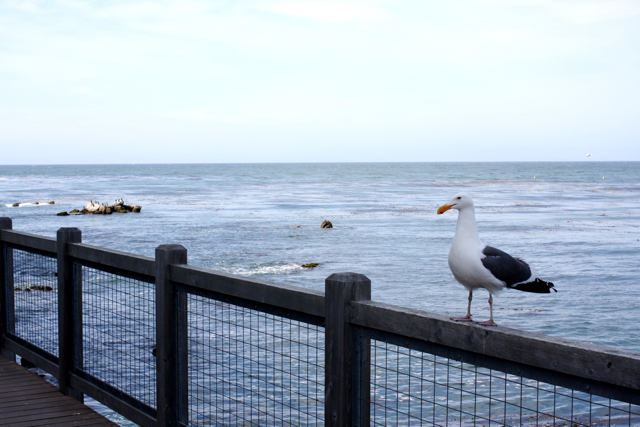
With some of our free time, Tim and I wander along Cannery Row, gazing at the ocean and taking pictures by the Monterey Aquarium. We grab a taxi to Whole Foods (addicts!) and see our favorite kombucha for $2.99 a bottle—this is not the sales price, mind you, just the typical one—and buy snacks for the plane rides home the next day.
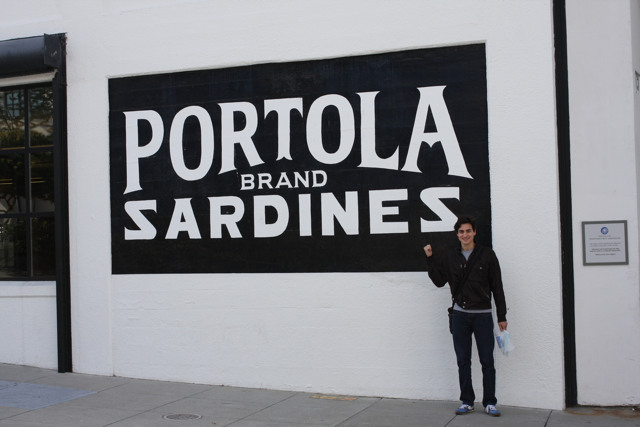
We’ve eaten well this whole short trip, from the snacks at cocktail hour:
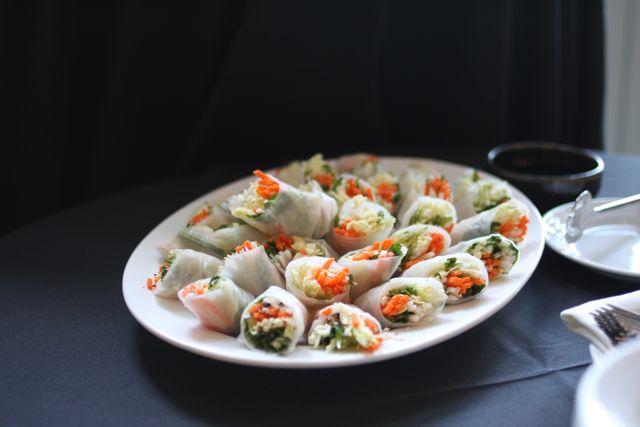

to the first night’s dinner at The Sardine Factory near our hotel, where Dole treated us to our choice of meal, which for us meant caprese salad and wild fish.
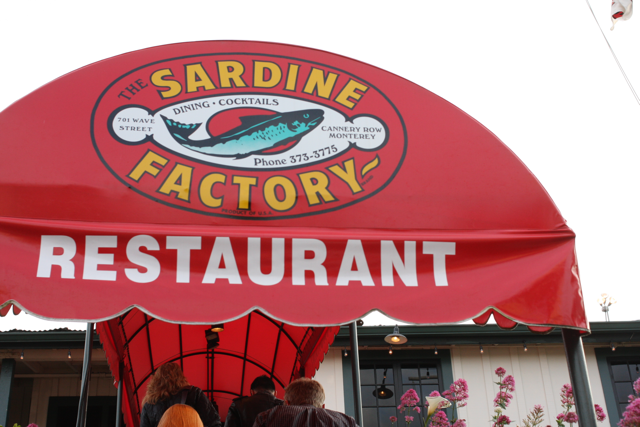
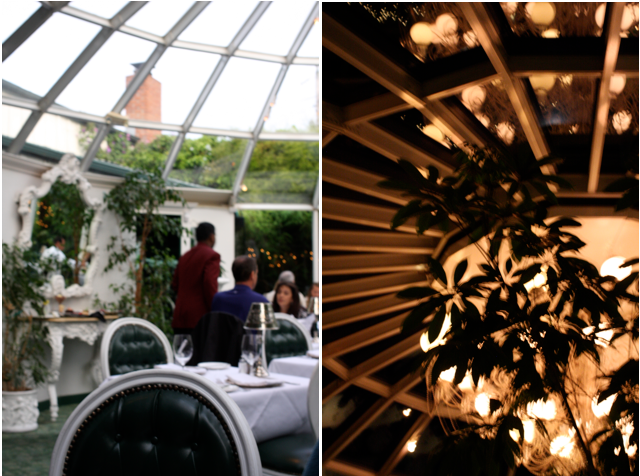
to today’s lunch at La Bicyclette in Carmel, easily one of our favorite meals all year (more information on that below):
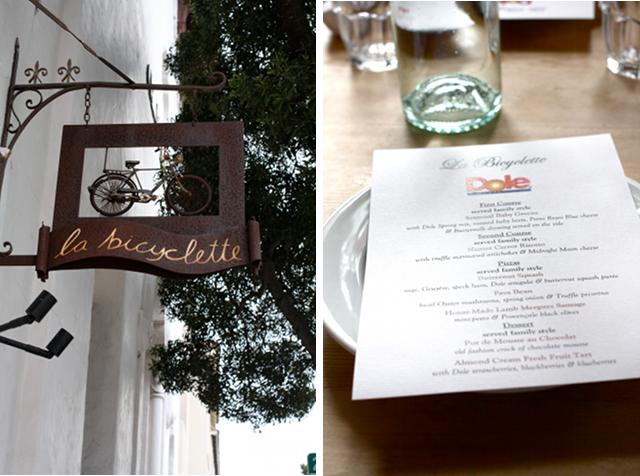
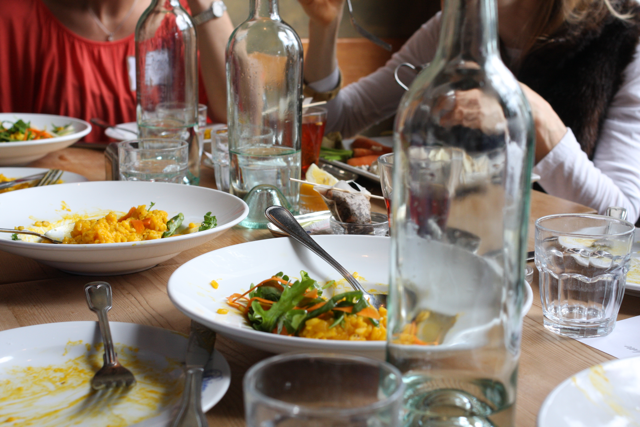


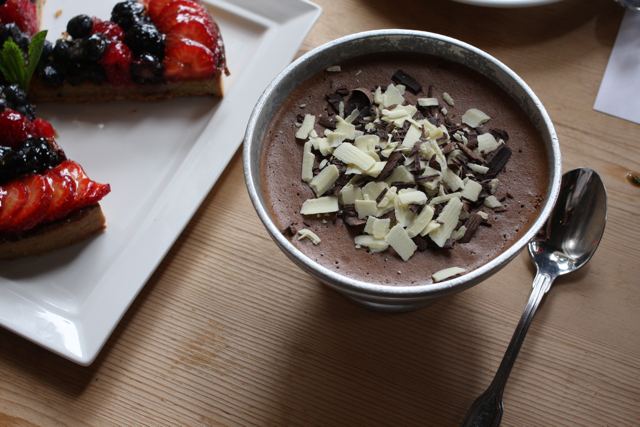
And from the food to the farm tours, Dole is surprising us—more than anything with its approachability and desire for interaction. This is a company that tells us its goal is to get people to eat more salad, and we appreciate that. Salad is easy to digest, filled with nutrients and, hello, it tastes good.
The one thing on Tim’s and my mind throughout the meals and sessions is the issue of GMOs and pesticides, particularly because lettuce is one of the most heavily sprayed foods, one that we always buy local and/or organic. We find out they don’t use GMOs in their salad production, ever—encouraging! Then someone asks about pesticides: Does Dole use them? Yes. But they say post-wash testing has shown 85% of their products have no traces left when they go out to the public, we see later because the lettuce is washed at least three times in chlorinated water before hitting consumers, in the case of iceberg lettuce, once on the field and then three times in the plant (this is all within FDA levels, they emphasize)—discouraging!
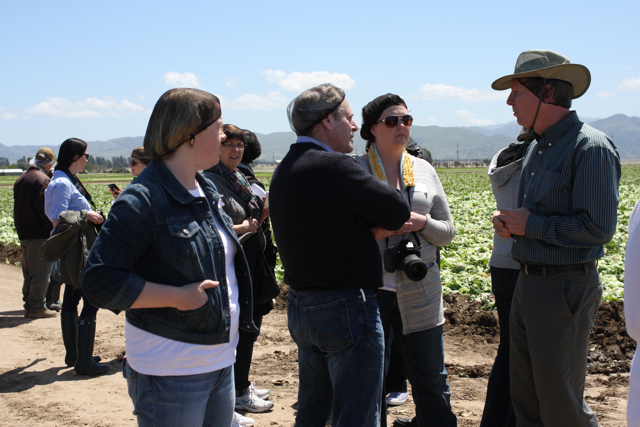
Here’s Tim’s more in-depth take on these issues:
To be honest, we don’t normally purchase Dole salads. For one thing, we want produce that was raised as clean as possible, without pesticides, whether or not it’s organic. Also, we want fresh–and while Dole has many processes in place to ensure freshness, they just can’t beat something that has been grown locally and harvested either the same day or within a couple days. Dole understands why I’d feel this way. I’m encouraged hearing Gil Oetzel, director of new product development, talk, as he understands the fact that plants and produce are living and that life continues to act out in the plant, even after harvest, through enzymes, bacteria and oxidation until the plant is no more. The closer to fully alive that you can eat a plant, the better—every minute a plant or fruit is cut or picked means a reduction of this life and energy.
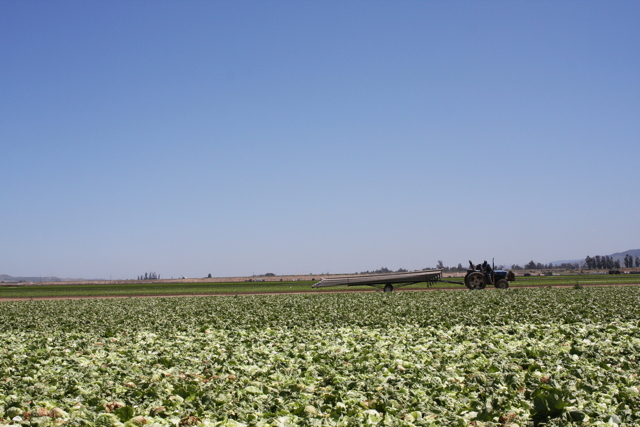
That said, through our entire trip, we’ve been seeing firsthand that Dole really is doing a great job at fulfilling their mission to have more and more people eating fruits and vegetables—and I think that is a great mission to have! They provide salad for people all over the country and world, in many cases in the best state that is available to those individuals. Dole salads are, no question, a better option than so much of the processed food available today. We applaud their desire to promote produce to mainstream America. And too, like Shanna wrote, Dole is open to discussion about concerns and even indicated a desire to move towards organics or a removal of pesticides if possible in the future.
At the same time, this trip just clarifies even stronger why I think the way I do about produce. In our current food system, far too many things are sterilized to the max. Dole, like other brands, uses chlorine solutions that, according to FDA guidelines, can be up to over ten times as much chlorine as in the public water supply (something we already try to avoid through filters).
The chlorine washes are applied to produce to ensure that it is free of all bacteria, good and bad, and this is part of the reason why Americans have such poor gut health. Our system decimates healthy intestinal flora through the continued use of bacteria-killers like antiobiotics and chlorine. For this reason, and rightly so, probiotics have been coming more to the forefront these days (see our post on kefir as an example). Traditionally, getting probiotics, or good bacteria, was as easy as going to the tree and picking a piece of fresh fruit, pulling berries right off the bush or eating lettuce right from the garden—all of which were still full of good bacteria that had not been sterilized by chlorine. It is very difficult to fully ascertain the effects of pesticides (even if washed off), chlorine and industrial processing to vegetables. On the other hand, it is pretty easy to see the traditional health benefits of pure produce the way God made it on the tree, from the plant or cultivated in the garden.

Our overall takeaways: At the end of our Dole trip, we both feel a sense of enrichment—thankful to have seen and learned about the way the world’s biggest provider of fruits and vegetables runs its operations. We have great respect for the way Dole is making itself open to dialogue and taking the initiative to seek out feedback, and we are hopeful that this will mean in the future, the company, along with its growers, will move more and more towards an even higher quality of product.
Places featured in this post:
Dole
Headquarters
2959 Monterey Salinas Highway
Monterey, California 93940
Hotel
InterContinental, The Clement Monterey
750 Cannery Row
831-375-4500
www.intercontinental.com/montereyic
Staying at the InterContinental was a little like reliving part of our honeymoon, as we spent our wedding night at one of their Chicago locations. In addition to our king-sized bed, in-room fireplace and balcony, we loved the hotel’s second floor Ocean Terrace with outside seating areas overlooking the water.
Dining
Dinner at The Sardine Factory
701 Wave Street – Cannery Row
831-373-3775
www.sardinefactory.com
Just walking distance from our hotel, this historic and highly acclaimed establishment was our first meal in Monterey and what a welcome! Eating in The Sardine Factory’s domed, glass-enclosed Conservatory Room was the definition of four-star treatment, especially since DOLE told us to order whatever we liked. Tim had the blackened halibut; I got the wild salmon; and we shared appetizers of heirloom tomato bruschetta.
Lunch at La Bicyclette
7th Avenue
Carmel, California 93923
831-622-9899
www.labicycletterestaurant.com
This was the place we were most looking forward to and the place we most hated to leave. Set in charming Carmel, La Bicyclette believes in cooking with local, organic and high-quality ingredients, and at their French-village-style café, they wowed us with a DOLE-focused meal including rainbow beet salad, creamy and comforting nantes carrot risotto, three different kinds of wood-fire-oven pizzas (fava bean and oyster mushroom, butternut squash and arugula, lamb sausage and mint pesto) and a chocolate mousse we’re already dreaming about re-creating.
*Disclaimer: Special thanks to Dole, who sponsored this visit to Monterey and the entire blogger summit; as well as to DGWB, the agency behind this trip, especially the welcoming Amanda Sheaffer, who organized and coordinated travel, activities and events. While this trip was sponsored, please note all opinions expressed on this blog are our own.



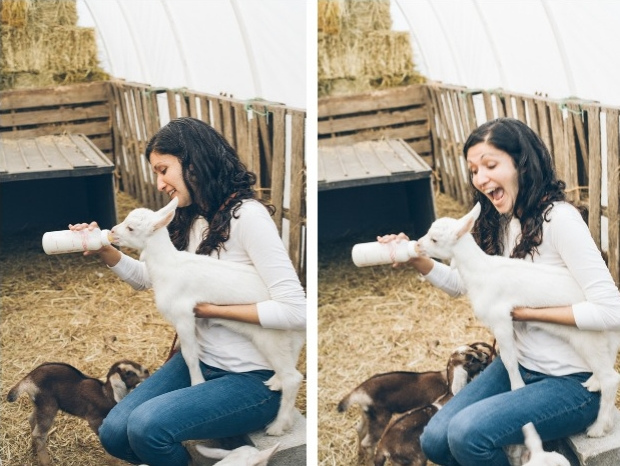
Thanks for this thoughtful post (and a trip down memory lane–your photos are spectacular!). I was also discouraged about the chlorine wash, though of course I understand the requirement to remain within government guidelines. Although they don’t recommend it, I’d re-wash the salad mixes if I bought them (since I wash my organic greens anyway, I don’t see this as an extra step). I agree wholeheartedly with you that the Dole veggies are so much better than most of the prepared and packaged foods the average consumer buys; and if they are not interested in, can’t afford or don’t have access to organic and/or local, these are a great choice. I was also struck by the company’s desire for more interaction with consumers and bloggers, and the approachability of everyone on staff–which, hopefully, will translate to some more ecologically-minded practices down the road. It was great to meet you both! 🙂
Thanks for this thoughtful response, Ricki! These are definitely good conversations to be having, not just with Dole, but among us bloggers and within the blog world. Just as there is real power in being a big influencer (like Dole), there is real power in our voices, as well as power in every single person’s purchases. Really glad to meet you as well and enjoyed reading your in-depth recaps! Hope to find ourselves working together again someday, whether in a lettuce field or otherwise. : )
I love this post. It is very informative and I never knew about the healthy bacterias being washed away with chemicals from store-bought produce. I always try to buy produce from local farmers when in season anyway, though. I wish there were more available here in NY when it isn’t summer. Thanks for sharing your trip! 🙂
Thanks for that comment, Rachel! We agree this information is sobering and makes us lean even more towards local farmers—the good news is that even in winter, greens are in season, so there should be ways to find it near you! And of course, now in this season of bounty that we’re entering, it’s such a joy to find fresh fruits and vegetables of all kinds. Let’s enjoy it while we can! : )
Found your site on FoodBlogs.com and thought I’d check it out. Subscribed to your feed and can’t wait to see what your next post will be!
Thanks for subscribing!
Shanna and Tim – I appreciate hearing such an honest perspective on your trip and experiences with Dole. So often when bloggers go on a sponsored trip or receive product that is sent to them from a company, the resulting blog post feels a bit forced. I think you both handled your trip and feelings about it well, by being fair to Dole while standing up for your own beliefs. Although we do eat a lot of non-organic lettuce, it really got me thinking.
Madison, That is such an encouraging comment to read—thank you! We really wrestled with how to write this post because, while we are very thankful for the experience, we are also passionate about being honest in this space. Your response is exactly what we hoped to communicate. Thanks for taking the time to leave it!
what an incredible trip! I felt like I could *almost* smell the produce of Salinas and Guilroy. Did you smell garlic? : ) Oh how I miss that area– so many great memories from trips with family and friends.
I had a duh-uh moment today while on your blog. I was recounting what you had said about the following thing and I was thinking, “who wouldn’t follow her blog? It’s awesome!”. And then I had this horrible feeling. And yep. I realized I haven’t ever subscribed! I think I’ve always looked for a google box, but being that your address is .com, you wouldn’t have one. I am very glad to have made this discovery and am happily now a “legal” subscriber : ) ha!
Can we just talk about the fact that you grew up in California? So. jealous. ! And haha about the subscription thing—I swear I wasn’t trying to guilt you into it with my comment. : ) I enjoy your site so much; I’ve told Tim about it at least four times in the last week! Thanks for stopping by the comment!
You got some great pictures! I wish I would have taken my larger camera, but my bag was already packed to the max 🙂
I’m so happy I had the chance to meet you two, and I wish we lived closer.
I agree with the majority of your post and I was definitely glad to hear that Dole doesn’t use any GMO seeds. I guess I wasn’t expecting that answer for some reason and it’s nice to know.
Thanks, Brandi! We loved meeting you, too! And I totally agree—I was really surprised about their not using GMOs and expected a different answer, too. Definitely nice to know.
Great post Shanalee! Isn’t Monterrey such a dream? It looks like the DOLE farm was excellent too. I love that their mission is to get more people eating fruits and vegetables. In our country, I often believe that should be our top priority, since diet affects so many other aspects of life–especially for kids. Thanks, too for stopping by my blog. Hope to see you around again soon!
Hi Claire, Was glad to find your site yesterday (after reading your post at the Delvin Farms blog–we’re in the same CSA!) and the way you’re profiling growers in the community. Thanks for stopping by!
Shannalee – Thanks for the beautiful post about your trip to Monterey. We enjoyed having you all here, and appreciate your honest feedback! We love having the opportunity to share our passion for providing an abundance of healthy, fresh, all natural and – most importantly! – delicious foods. Enjoyed having dinner with you and Tim.
cm
Thank you, Chris—we so enjoyed meeting you and the other Dole team members, and we appreciate your willingness to consider feedback so much. Thanks again for including us and for sharing your work with us!
Hi Shannalee and Tim! It was great to meet both of you on the Dole trip. I enjoyed reading your post and of course seeing all of the beautiful photos that bring me right back to sunny Cal. Of course, it’s sunny (and hotter) here in Arizona!
Just a few factoids for you and everyone — the only GMO crops in the U.S. today are soybean and corn. There are NO fruits or vegetables sold in the US that are GMO. Also, something else to get you thinking….organic farms also use organic fertilizers and (gasp) organic pesticides…so don’t be fooled that USDA organic is always the better option. You need to confirm the type of pesticide-management these folks use. Now that many organic vegetable companies are going industrial, it would be interesting to see how they manage pests and yield. Finally, the chlorine-wash issue. It was encouraging to hear that 85% of whatever was sprayed on the veggies was washed off in processing — I’m still going to eat as many fruits and veggies that I can get my hands on..preferably local, sustainable and clean…but as a dietitian, the best recommendation that I could give to anyone is to just eat more of the stuff.
I appreciate your honesty and opinions in your blog and have enjoyed reading many of your older posts. No wonder you two fell in love vis-a-vis your blog! Great stuff! Thank you and good luck!
Hi Barb,
It was nice meeting you as well. We had a great time and definitely enjoyed our visit.
I am well aware of those facts and also that 90% of canola grown here and Canada is genetically modified as well. Of course organic farms use organic pesticides and fertilizers; some use nothing and have higher loss rates–not always a bad thing. Generally, smaller, non-industrial farms are not only producing a higher quality product, but also with less toxic effects to workers or people in contact with the type of pesticides. Having personally worked with these pesticides, as well as friends who have worked with them, as well as having read studies on their effects, we would prefer better alternatives or no pesticides at all (and deal with the bacteria and/or parasites on the plant). As for the chlorine wash, you didn’t respond to it. The pesticides are what get washed off (85%). The chlorine is dried on and some may be evaporated. I don’t think we will ever agree that chlorine is a good way to sterilize a plant. It is used because it kills everything living. It is neither healthy for the body nor does it keep a living food alive–which is best for a living body.
Also, as mentioned in the post it is far better to eat produce (any produce) than any overly processed, manufactured food. So we definitely can agree with your recommendation to people (to eat more fruits and veggies). I just think people should be educated on what goes into it and also the effects of working with chemicals.
Great post and I love how you handled all the issues. I’ll definitely be linking to this one! Fantastic meeting you both and I’m now a subscriber. 🙂
We loved meeting you, too, Stephanie! It’s so good to get to talk with people like you who are excited about the healing power of good foods. Looking forward to your recap!
Just to add to the GMOs that are on the market today, you also need to include:
– Sweet Corn (BT-for insects)
– Zucchini (For yield)
– Summer Squash (for Percoious Yellow Gene)
You also need to keep in mind that Cell Fusion, which is defined as GMO since for most crops it is an artificial transfer of genes from one species to another that could not occur in nature. There are few exceptions to this, noteably Corn, Onions and Radishes.
The list of crops using Cell Fusion is LONG:
– Almost all Broccoli
– Almost all Cabbage
– Most Cauliflower
– I will not continue on as the list is almost endless.
The reason for using Cell Fusion is get a male sterile line to use for breeding. Why do this? It allows for a hybrid that will be 100% pure seed. Normally when you cross pollinate two plants you will get some off type plants in the seed. Meaning when the farmer plants it he will get some plants that look like one parent or the other. The plants used to breed seed are usually ugly things with poor marketability. The goal of breeding is to isolate traits in the parents and then cross them to hopefully get the best traits from both parents (Good yield combined with good disease resistance).
Cel Fusion is mostly used to obtain male sterility in the female parent. If the female parent is male sterile (meaning she makes no viable pollen) she can not pollinate herself (most veggies can pollinate themselves). She can only obtain pollen from the father plant. This means 100% of the seed produced will be F1 or hybrid seed.
The problem is that MOST veggies have no naturally occuring male sterility. So most plant breeders take a cell from a radish, sunflower, etc. that DOES have male sterility and use chemicals to break down the cell wall of the radish, sunflower, etc. They then do the same to to the crop they want to tansfer the gene into, lets say cabbage. Now we have two cells from to different species that have no cell walls. The breeder then uses electricity to “fuse” these two protoplasts (cells without cell walls) together. What we wind up with is a new cell that has some DNA from a sunflower, radish, etc. and some DNA from a cabbage.
This cell is then forced to replicate with additional chemicals until it forms a new plant, which looks like a cabbage. This new cabbage plant now has male sterility in it’s DNA, along with a host of other DNA from the donor that we have little knowledge of what it does. Traditional plant breeding is then done to obtain the new hybrid seed.
SO, many of the veggies you eat are probably GMO without you knowing about it. Most seed catalogs will not list whether the breeder used cell fusion or not since it is not considered GMO by the USDA. The USDA organic program now permits artificial Cell Fusion in plant breeding as long as the two plants are in the same taxonomic family. Radishes, Cabbage and Broccoli are all in the same taxonomic family, but they can not breed with each other in nature. So your broccoli is most likely not really broccoli any more. It is radoccoli or maybe a broccolish. Of if they used Sunflower cells is broccoliflower or cabbiflower. The French did testing of most of the conventional cabbage for sale in France and found that almost all of it had detectable Sunflower or radish DNA.
This means that even your Organic produce can now have artificial GMO’s in them that nature would not allow. You can be 100% certain that the large organic companies were pushing for this. They WANT to use conventional breeding and still label it organic. The only difference I see between cell fusion and gene splicing (what MOST people think of as GMO today) is that with cell fusion you have no clue what genetic material is being fused beyod the genes you wanted. To be upfront gene splicing can put animal DNA in plants where cell fusion can not.
The USA is now the only country in the world to allow artifical cell fusion to be used in products labeled Organic. They rest of the world has banned it, even within the same taxonomic family. If you try to ask your local organic grower about this he will probably have no clue what you are talking about. He may not even know the “organic” seed he bought has been bred using cell fusion and may contain DNA from another species.
I am not an organic grower, but I use many organic practices. I avoid all seed varieties that use artifical gene transfer. I have had to call at LEAST 10 different breeders to inquire HOW the seed I am buying was bred. Is this gene transfer harmful? Who knows! The authorities would have us believe it is just fine as long as the plants are in the same family. Hmm. I would like my radish to actually be a radish and my broccoli to actually be broccoli.
Potatoes and Tomatoes have also been put on the market with GMO traits. Potatoes for insect management and tomatoes for shelf life. Both of these are not on the market TODAY as far as I know, but Monsanto is pushing them in other countries today.
So, as you can see, GMOs are in MOST of the veggies you are eating today in one way or another. When Dole said their lettuce was GMO free they may have only told you half of the truth. It may not have been bred using gene splicing with DNA from animals, bacteria, fungus, etc., but I am willing to bet they DID use cell fusion and there is radish, sunflower or other DNA in that lettuce! Maybe a follow-up question would be in order. My guess is that they will dodge that question.
Wow, thanks for the input, Matthew! We appreciate your adding to the conversation and sharing additional info — PS I see your farm is in Wisconsin! Wish I’d known about you when I was living in Chicago. : ) Like the sound of what you’re doing.
@Barb Ruhs
As to organic fertilizer and Pesticides vs conventional. There is a HUGE difference in what the makeup of the “fertilzer” and the “pesticide” between conventional and organic. The term “fertilizer” is used to describe nutrients the plant needs to grow. The three macro nutrients (major ones) are Nitrogen, Phosphorous and Potassium.
The “stuff” you put on your field to get these nutrients to your plant is called “fertilizer”. Ammonium Nitrate, Cow Manure and Alfalfa will ALL supply nitrogen to your crop. The first is produced in a chemical factory and usually is harmful to earth worms and the environment in it’s production, but it will supply nitrogen to a vegetable crop. Alfalfa is a legume crop. It has a special symbiotic lifecycle with a microbe that infects it’s roots. When infected, the microbe extracts carbohybrates from the alfalfa and deposits nitrogen (which is extracted from the air in pure form) in nodules around the roots. The microbe deposits MORE nitrogen than the alfalfa uses. When the farmer plows the alfalfa under the nitrogen in the nodules around the roots is released and available to the next veggie crop.
The organic farmer has GROWN his own fertilizer and the conventional farmer has had to put an artifical chemical fertilizer on his field that kills the beneficial organizims in the soil. So the “green manure” is fertilizer, but it is natural and does not harm the environment. The cow manure works as well, but the organic farmer needs to be careful of how soon he plants veggies after putting on cow manure and it may have e-coli and other bugs we don’t want. Usually 8 months must pass from application of manure to harvest of veggies.
As for pesticides, MOST organic pesticides are natural oils and extracts from other plants. The insecticide Pyganic is an extract from the chrysanthemum flower. It is a broad spectrum insecticide that kills many bugs. Neem oil from the neem tree is extracted like maple syrup and concentrated. It is used as a fungicide and insecticide. MOST of the organic “pesticides” are simple naturally sourced materials that exist in small amounts in nature. Would you drink Pyganic, of course not. Is it dangerous to consume in the amounts applied to produce? NOPE! Wash it first, but the compound is not environmentally damaging when used properly. It breaks down in the environment.
MOST synthetic chemical pesticides ARE damaging to people and the environment. They take a VERY long time to degrade, many take years or decades.
I think it is terrible that you try to lump orgainc and conventional producers into the same bucket because of the terms “Fertilizer” and “Pesticide”. Organic producers can not even used a pesticide without a documented need. Most conventional producers have a spray schedule they stick to whether it is needed or not. It is cheap insurance to make sure they get a good crop.
Hmm it appears like your site ate my first comment
(it was super long) so I guess I’ll just sum it up what I submitted and say, I’m
thoroughly enjoying your blog. I too am an aspiring blog writer
but I’m still new to the whole thing. Do you have any tips for inexperienced blog writers? I’d really appreciate it.
It’s been so very much appreciated!
Hi Janessa, Sorry about your first comment! But thanks so much for persevering. : ) We’ve actually set up a page that answers questions new bloggers have — you can check it out here: http://foodloveswriting.com/starting-a-food-blog/